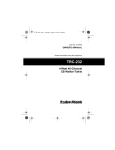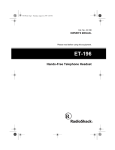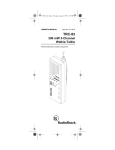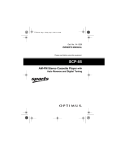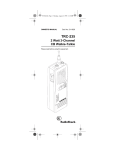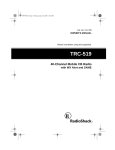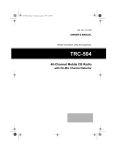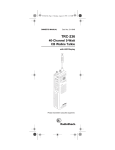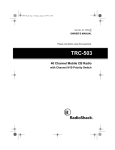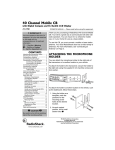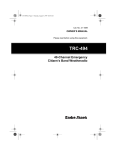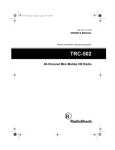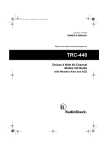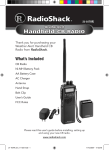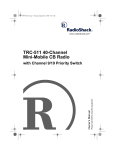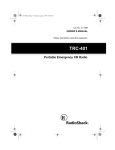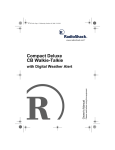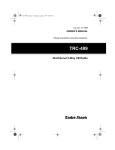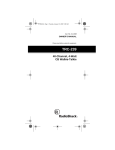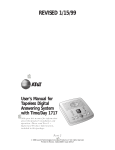Download Radio Shack TRC-237 User's Manual
Transcript
21-1650.fm Page 1 Thursday, August 5, 1999 11:43 AM OWNER’S MANUAL Cat. No. 21-1650 TRC-237 40-Channel 5-Watt CB Walkie Talkie with Channel 9/19 Priority Switch Please read before using this equipment. 21-1650.fm Page 2 Thursday, August 5, 1999 11:43 AM FEATURES Your RadioShack TRC-237 40-Channel 5Watt CB Walkie Talkie with Channel 9/19 Priority Switch is a portable, two-way radio you can carry almost anywhere. The channel priority switch lets you quickly switch to either Channel 9 to report emergency situations, or to Channel 19 to transmit and receive information about road and traffic conditions. You can use your TRC-237 around the house, in your office, or in your car or boat. You can also use it on fishing trips, or at your business for supervisory, security, or warehouse personnel. Your TRC-237 also has the following features: Transmit Power High/Low Switch — lets you reduce the transceiver’s power output during short-range transmissions to save battery power. Transmit Indicator — lights whenever you press the transmit button. Modulation Indicator — lights when you speak into the microphone. The indicator brightens as modulation increases. Built-In Modulation Limiter Circuit — automatically adjusts to a variety of voice levels to ensure a clear transmission. PLL (Phase-Locked-Loop) Frequency Synthesizer — provides reliable and exact tuning. Adjustable Squelch — helps to eliminate noise between transmissions. © 1997, 1998 Tandy Corporation. All Rights Reserved. RadioShack is a registered trademark used by Tandy Corporation. 2 21-1650.fm Page 3 Thursday, August 5, 1999 11:43 AM 2-Digit LED Display — lets you easily see the selected channel number. Automatic Noise Limiter (ANL) Circuit — reduces noise caused by nearby electrical equipment such as motors or automotive ignition systems. Battery Test Button and Battery Indicator — lets you check the batteries’ condition to find out if they need replacing. Flexible Antenna with BNC Connector — provides excellent reception and transmission, and is designed to help prevent antenna breakage. Automatic Display Dimmer — the channel display automatically brightens when you press most buttons. Then, after a few seconds, it dims to save battery power. Power/Charging Jack — lets you power your TRC-237 from an AC or DC power source, so you can use the TRC-237 without draining the batteries. And, lets you charge nickel-cadmium batteries without removing them from the TRC-237. Note: You need eight AA alkaline batteries or ten nickel-cadmium rechargeable batteries (not supplied) to power your TRC-237. We recommend you record the TRC237’s serial number here. The serial number is located on the radio’s back panel: 3 21-1650.fm Page 4 Thursday, August 5, 1999 11:43 AM FCC INFORMATION The Federal Communications Commission (FCC) does not require you to have a license to operate this walkie talkie. However, the FCC does require that you read and know Part 95 of FCC Rules. These rules apply to the operation of a Class D CB. We have provided a copy of these regulations with your TRC-237. Internal adjustments and/or modifications can lead to illegal operation as defined by Part 95 of FCC Rules. Such illegal operation can lead to very serious consequences. To be safe and sure: • Never open your TRC-237’s case. • Never modify your TRC-237. Your TRC-237 might cause TV or radio interference even when it is operating properly. To determine whether your TRC-237 is causing the interference, turn off your TRC-237. If the interference goes away, your TRC-237 is causing it. Try to eliminate the interference by: • Moving your TRC-237 away from the TV or radio • Contacting your local RadioShack store for help Warning: Do not open your TRC-237 to make any internal adjustments. Any internal adjustments should be made only by authorized service personnel. 4 21-1650.fm Page 5 Thursday, August 5, 1999 11:43 AM CONTENTS Powering the CB ................................ 6 Using the POWER Jack and ALKALINE/NI-CD Switch .................. 6 Using Batteries ................................. 7 Testing the Battery Power .......... 10 Recharging Nickel-Cadmium Batteries ..................................... 10 Using Vehicle Battery Power ........... 12 Using AC Power ............................. 13 Connecting the Antenna .................. 15 Connecting an Optional Antenna ........................ 16 Operation .......................................... 18 Receiving Transmissions and Adjusting Squelch .......................... 18 Transmitting .................................... 20 CB Operation Tips ........................... Common Uses for a CB Radio ....... Business Uses ........................... Personal Uses ........................... Using Common 10-Codes .............. CB Courtesy ................................... Maximum Range ............................ 21 21 21 21 22 24 24 Troubleshooting ............................... 25 Maintenance ..................................... 26 Specifications .................................. 27 5 21-1650.fm Page 6 Thursday, August 5, 1999 11:43 AM POWERING THE CB You can power your TRC-237 from any of these sources (none supplied): • Eight AA alkaline batteries with the two supplied dummy batteries • Ten rechargeable cadmium batteries AA nickel- • 12-volt vehicle battery power using a fused power cord • Standard AC power using a power supply USING THE POWER JACK AND ALKALINE/NI-CD SWITCH The POWER jack lets you connect an external power source (such as your vehicle’s battery power or AC power), or connect a battery charger to charge nickel-cadmium batteries while they are in the TRC-237. The TRC-237 also has a slide switch (ALKALINE/NI-CD) inside the battery compartment that you must set correctly, depending on what power source you are using and whether or not you want to charge rechargeable batteries while they are in the TRC-237. 6 21-1650.fm Page 7 Thursday, August 5, 1999 11:43 AM • Set it to ALKALINE before you connect an external power source (vehicle battery power or AC adapter) to the POWER jack or while you are using internal batteries (alkaline or rechargeable). • Set it to NI-CD only when you connect a battery charger to the POWER jack to charge the installed rechargeable batteries. Warning: To avoid injuring yourself or damaging the TRC-237, connect a battery charger to the POWER jack only when nickel-cadmium batteries are installed (see “Recharging Nickel-Cadmium Batteries” on Page 10). Never try to recharge non-rechargeable batteries. They could get very hot and explode. Note: You can connect an external power source for power regardless of the type of batteries you installed. USING BATTERIES You can power the TRC-237 from eight AA alkaline batteries (such as RadioShack Cat. No. 23-552) with the two supplied dummy batteries, or 10 rechargeable AA nickel-cadmium batteries (such as Cat. No. 23-125). 7 21-1650.fm Page 8 Thursday, August 5, 1999 11:43 AM Cautions: • Always use fresh, or freshly charged, batteries of the required size and recommended type. • Do not mix old and new batteries, different types of batteries (standard, alkaline, or rechargeable nickel-cadmium), or rechargeable batteries of different capacities. Follow these steps to install the batteries. 1. If the TRC-237 is on, turn OFF/VOLUME fully counterclockwise until it clicks to turn it off. 2. Slide the strap on the back of the TRC-237 through the buckle and the battery compartment cover to remove it. 3. Slide the battery compartment cover in the direction of the arrows to remove it. 8 21-1650.fm Page 9 Thursday, August 5, 1999 11:43 AM 4. Be sure ALKALINE/NI-CD inside the battery compartment is set to ALKALINE. 5. Put eight AA alkaline batteries and the two supplied dummy batteries, or ten AA nickel-cadmium batteries into the battery compartment, as indicated by the polarity symbols (+ and –) marked inside. Note: Before you use the TRC-237 with nickel-cadmium batteries, you need to charge the batteries (see “Recharging Nickel-Cadmium Batteries” on Page 10). 6. Replace the battery compartment cover and the strap on the back of the TRC-237. Cautions: • If you will not be powering the TRC237 from internal batteries for several months, remove the batteries. • Dispose of old batteries promptly and properly. 9 21-1650.fm Page 10 Thursday, August 5, 1999 11:43 AM Testing the Battery Power 1. Turn on the TRC-237 by rotating OFF/VOLUME clockwise until it clicks. 2. Hold down BATT TEST. If the indicator lights, there is enough battery power to operate the CB. If the indicator is dim or does not light, replace or recharge the batteries. Recharging Nickel-Cadmium Batteries You can use a battery charger, Cat. No. 23-249 (not supplied), to charge or recharge nickel-cadmium batteries while they are inside the TRC-237’s battery compartment. Do not use the TRC-237 while you are charging the nickel-cadmium batteries. Cautions: • Use only the recommended battery charger to recharge the batteries in the TRC-237. Other chargers could damage your TRC-237 or the batteries. • Be careful not to overcharge nickelcadmium batteries. • To prevent damage to rechargeable nickel-cadmium batteries, never charge them in an area where the temperature is above 90°F (32°C) or below 40°F (4.5°C). 10 21-1650.fm Page 11 Thursday, August 5, 1999 11:43 AM Follow these steps to charge nickelcadmium batteries in the TRC-237. 1. If the TRC-237 is on, turn OFF/VOLUME fully counterclockwise until it clicks to turn it off. 2. Set ALKALINE/NI-CD inside the battery compartment to NI-CD (see “Using the Power Jack and ALKALINE/ NI-CD Switch” on Page 6). 3. Connect the battery charger’s 5.5 mm outer diameter./2.1 mm inner diameter barrel plug to the POWER jack on the side of the TRC-237, then plug the battery charger’s plug into a standard AC outlet. It takes about 24 hours to charge new or fully discharged nickelcadmium batteries. Subsequent charges take about 16 to 18 hours. 4. When charging is complete, unplug the battery charger’s plug from the AC outlet. Then disconnect the battery charger’s barrel plug from the POWER jack. 5. If the TRC-237 is on, turn OFF/VOLUME fully counterclockwise until it clicks to turn it off. Then set ALKALINE/NI-CD to ALKALINE. 11 21-1650.fm Page 12 Thursday, August 5, 1999 11:43 AM Note: You can use an external charger (such as Cat. No. 23-134, not supplied) to recharge the nickel-cadmium batteries. After removing the batteries from the TRC-237, follow the instructions that come with the external charger. Important: Your TRC-237 is capable of using nickel-cadmium batteries. At the end of the batteries’ useful life, they must be recycled or disposed of properly. Contact your local, county, or state hazardous waste management authorities for information on recycling or disposal programs in your area. Some options that might be available are: municipal curbside collection, drop-off boxes at retailers such as your local RadioShack store, recycling collection centers, and mail-back programs. USING VEHICLE BATTERY POWER You can power your TRC-237 from your vehicle’s cigarette-lighter socket with an optional 12-volt DC fused power cord (such as Cat. No. 270-1533). Cautions: • You must use a DC fused cord that supplies 12 volts and delivers at least 1200 milliamps of vehicle power. Its center tip must be set to positive, and its plug must correctly fit the TRC-237’s POWER jack. The recommended fused cord meets these specifications. Using a fused cord that does not meet these specifications could damage the TRC-237 or the fused cord. 12 21-1650.fm Page 13 Thursday, August 5, 1999 11:43 AM • When you finish using the TRC-237, unplug the fused cord from the cigarette-lighter socket before you disconnect it from your TRC-237. 1. If the TRC-237 is on, turn OFF/VOLUME fully counterclockwise until it clicks to turn it off. 2. Be sure ALKALINE/NI-CD inside the battery compartment is set to ALKALINE. 3. Insert the power cord’s 5.5 mm outer diameter/2.1 mm inner diameter barrel plug into the POWER jack. 4. Plug the power cord’s other end into your vehicle’s cigarette-lighter socket. Note: If the TRC-237 does not operate when you use the DC power cord, unplug the cord from the cigarette-lighter socket and clean any ashes or debris from the socket. If your TRC-237 still does not work, check the fuse in the DC power cord and replace it if necessary. USING AC POWER You can power your TRC-237 from standard AC power using an optional AC-to12 V DC power supply (such as Cat. No. 22-504) and an optional DC fused power cord (such as Cat. No. 270-1533). 13 21-1650.fm Page 14 Thursday, August 5, 1999 11:43 AM Cautions: • The power supply must be able to deliver 12 volts and at least 1200 milliamps of power. The recommended power supply meets these specifications. Using a power supply that does not meet these specifications could damage the TRC-237 or the power supply. • You must use a DC fused cord that supplies 12 volts and delivers at least 1200 milliamps of power. Its center tip must be set to positive, and its barrel plug must correctly fit the TRC-237’s POWER jack. The recommended fused cord meets these specifications. Using a fused cord that does not meet these specifications could damage the TRC-237 or the fused cord. • To help prevent an electrical short, unplug the DC fused cord’s plug from the AC adapter’s power socket before you unplug the cord’s barrel plug from the TRC-237. Follow these steps to connect the TRC237 to AC power. 1. If the TRC-237 is on, turn OFF/VOLUME fully counterclockwise until it clicks to turn it off. 2. Connect the DC fused cord’s 5.5 mm outer diameter/2.1 mm inner diameter barrel plug to the TRC-237’s POWER jack. 3. Be sure ALKALINE/NI-CD inside the battery compartment is set to ALKALINE. 4. Plug the DC fused cord’s other end into the power supply’s power socket. 5. Plug the power supply into a standard AC outlet, then turn on the power supply. 14 21-1650.fm Page 15 Thursday, August 5, 1999 11:43 AM Note: If the TRC-237 does not operate when you use the DC fused cord, turn the power supply off, unplug the cord from the power supply’s power socket, then clean any debris from the socket. If your TRC237 still does not work, check the fuse in the DC fused cord and replace it if necessary. CONNECTING THE ANTENNA Caution: To prevent damage to your TRC-237, you must connect an antenna before you operate it. Follow these steps to attach the supplied flexible antenna to your TRC-237. 1. Align the slots around the antenna’s connector with the tabs on the antenna jack on top of the TRC-237. 2. Press the antenna down over the jack and turn the antenna’s base clockwise until it locks into place. To remove the antenna, turn the antenna’s base counterclockwise until it unlocks, then lift it off the antenna jack. 15 21-1650.fm Page 16 Thursday, August 5, 1999 11:43 AM Connecting an Optional Antenna Your walkie talkie comes with a flexible antenna that is ideal for most applications. However, the walkie talkie’s antenna jack makes it easy to connect other types of antennas, too. For mobile or base station use, you might want to connect an optional external antenna. Your local RadioShack store carries a wide selection of external mobile or outdoor basestation antennas. Choose the one that best meets your needs. When deciding on a mobile or basestation antenna and its location, consider the following: • The location of the antenna should be as high as possible. • The antenna and antenna cable should be as far as possible from sources of electrical noise (appliances, other radios, and so on). • The antenna should be vertical for the best performance. Note: When connecting an optional antenna, always use 50-ohm coaxial cable, such as RG-58 or RG-8. For lengths over 50 feet, use RG-8 low-loss dielectric coaxial cable. If the coaxial cable’s connector does not fit into the antenna jack, you might also need a PL-259-to-BNC antenna plug adapter, such as Cat. No. 278120. Your local RadioShack store carries a wide variety of coaxial antenna cable and connectors. 16 21-1650.fm Page 17 Thursday, August 5, 1999 11:43 AM Follow the installation instructions supplied with the antenna, route the antenna cable to the TRC-237, then connect it to the antenna jack. Cautions: • Do not run the cable over sharp edges or moving parts. • Do not run the cable next to power cables or other CB antenna cables. • Do not run the cable through a vehicle’s engine compartment or other areas that produce extreme heat. • Follow all cautions and warnings included with the antenna. Warning: When installing or removing a base station CB antenna, use extreme caution. If the antenna starts to fall, let it go! It could contact overhead power lines. If the antenna touches the power line, contact with the antenna, mast, cable or guy wires can cause electrocution and death! Call the power company to remove the antenna. DO NOT attempt to do so yourself. 17 21-1650.fm Page 18 Thursday, August 5, 1999 11:43 AM OPERATION Before you use your TRC-237, we recommend you read “CB Operation Tips” on Page 21, which contains information to help you use it effectively and courteously. RECEIVING TRANSMISSIONS AND ADJUSTING SQUELCH 1. If you did not connect an external antenna, hold the TRC-237 so the antenna is vertical. 2. Turn on the TRC-237 by turning OFF/ VOLUME clockwise until you hear a click and a hissing sound. 3. Set OUT – CH9 – CH19 on top of the TRC-237 for the channel you want to tune: • To quickly tune to Channel 9, set it to CH9. 9 flashes on the display. • To quickly tune to Channel 19, set it to CH19. 19 flashes on the display. • To tune to any channel other than Channel 9 or Channel 19, set it to OUT. The previously selected channel number appears on the display. Note: When you tune a channel, the channel’s number appears or flashes on the display for about 20 seconds then fades, to save battery power. To continuously display the channel number, press and hold DISPLAY on the side of the TRC-237. 18 21-1650.fm Page 19 Thursday, August 5, 1999 11:43 AM To redisplay the channel number for about 20 seconds, simply press and release DISPLAY. 4. If you set OUT – CH9 – CH19 to OUT, repeatedly press CH s to select higher channels, or CH t to select lower channels. To move rapidly through the channels, hold down CH s or t. 5. Adjust OFF/VOLUME to a comfortable listening level. 6. Adjust SQUELCH to cut out the background noise. Wait until there is no signal on the channel, then slowly turn SQUELCH clockwise until the background noise stops. 19 21-1650.fm Page 20 Thursday, August 5, 1999 11:43 AM Note: Do not turn SQUELCH too far clockwise because you might also cut out weak signals. 7. To turn off the TRC-237, turn OFF/ VOLUME toward OFF until it clicks. TRANSMITTING 1. Follow Steps 1–6 in “Receiving Transmissions and Adjusting Squelch” on Page 18. 2. Hold the TRC-237 2 to 3 inches from your mouth. Press and hold PUSH TO TALK on the side of the TRC-237. TX on the front of the TRC-237 lights. Speak into the microphone. MOD lights. When you finish speaking, release the button. TX and MOD turn off. Note: Do not speak too loudly when transmitting. It does not make your signal any stronger, and might distort your transmission. Important: Channel 9 is reserved for motorist assistance and for reporting emergency information about accidents, hazardous road conditions, and so on. If you are using Channel 9, always give emergency messages priority. 3. To turn off the TRC-237, turn OFF/ VOLUME toward OFF until it clicks. 20 21-1650.fm Page 21 Thursday, August 5, 1999 11:43 AM CB OPERATION TIPS The following tips will help you get the most enjoyment from your TRC-237. COMMON USES FOR A CB RADIO Business Uses • Truck drivers and delivery personnel can learn road and traffic conditions and get assistance in locating destinations. A walkie talkie is also good company on those “long hauls.” • On construction crews, a walkie talkie quickly pays for itself when you are calling for additional materials or coordinating the activities of different work crews. • For security officers, a walkie talkie is more than a convenience — it is a must for both safety and efficiency. Personal Uses • Keep in touch with home while driving to work, to the store, or to a social activity. Let your family know you are tied up in traffic or that you will stop by the store on the way home. • If you are a two-car (or more) family, walkie talkies are great for communicating with family members while they are in their cars. • Contact friends or neighbors — find out “what’s happening” or plan a gettogether. • Ever have car trouble or run out of gas on the highway? What an assurance it is to be able to radio for assistance. 21 21-1650.fm Page 22 Thursday, August 5, 1999 11:43 AM • Camping, fishing, and other sports are more fun with a walkie talkie. Locate a friend or find out “what’s cooking” back at camp. USING COMMON 10-CODES Citizen’s band operators have largely adopted the 10-codes for standard questions and answers. Their use permits faster communication and better intelligibility in noisy areas. This table lists the codes adopted by the Associated Public Safety Communications Officers (APCO). Code Meaning 10-1 Cannot understand your message. 10-2 Your signal is good. 10-3 Stop transmitting. 10-4 Message received and understood. 10-5 Relay information to _________. 10-6 I am busy. 10-7 Out of service. 10-8 In service. 10-9 Repeat last message. 10-10 Negative (No). 10-11 _____________ in service. 10-12 Stand by. 10-13 Report ___________ conditions. 10-14 Information. 22 21-1650.fm Page 23 Thursday, August 5, 1999 11:43 AM Code Meaning 10-15 Message delivered. 10-16 Reply to message. 10-17 En route. 10-18 Urgent. 10-19 Contact __________. 10-20 My location is __________. 10-21 Call ________ by telephone. 10-22 Cancel last message. 10-23 Arrived at the scene. 10-24 Assignment complete. 10-26 Estimated time of arrival is ____. 10-30 Use caution. 10-31 Pick up. 10-33 Emergency traffic. Clear the channel. 10-34 The time is _____. Note: Although this table lists the 10codes’ meanings in the form of a statement, they can also be phrased as questions (10-6: Are you busy?, 10-20: What is your location?). 23 21-1650.fm Page 24 Thursday, August 5, 1999 11:43 AM CB COURTESY • Wait for a pause in someone else’s transmission before you ask for a break. • If you do not receive an answer to your call after a second attempt, sign off and wait several minutes before trying again. • Do not press and hold PUSH TO TALK when you are not talking. (This is called dead keying.) • Assist callers with directions, information about road conditions, and any other reasonable requests. MAXIMUM RANGE The maximum range and quality of CB transmissions vary depending on these conditions: • Amount of power in the batteries • The surrounding terrain — mountains and tall buildings limit the range • Weather conditions • The number of nearby CBs operating on the same channel To ensure maximum range, always keep fresh alkaline batteries or fully charged nickel-cadmium batteries in your TRC237 when using battery power. 24 21-1650.fm Page 25 Thursday, August 5, 1999 11:43 AM TROUBLESHOOTING If your TRC-237 is not working as it should, follow these suggestions to see if you can eliminate the problem. If you cannot, take it to your local RadioShack store for assistance. Symptom Suggestion Weak, bad, or no reception. Be sure the TRC-237 is turned on. Be sure the volume is turned up. Be sure the supplied flexible antenna or an external antenna is attached to the TRC237’s antenna jack. Be sure the batteries are not weak (see “Testing the Battery Power” on Page 10). Be sure you are not pressing PUSH TO TALK . Trouble with transmission Be sure the supplied flexible antenna or an external antenna is attached to the TRC237’s antenna jack. Be sure you are fully pressing PUSH TO TALK . Be sure the batteries are not weak (see “Testing the Battery Power” on Page 10). Channel select buttons do not work. Make sure OUT – CH9– CH19 is set to OUT. 25 21-1650.fm Page 26 Thursday, August 5, 1999 11:43 AM MAINTENANCE Your RadioShack TRC-237 40-Channel 5-Watt CB Walkie Talkie with Channel 9/ 19 Priority Switch is an example of superior design and craftsmanship. The following suggestions will help you care for your TRC-237 so you can enjoy it for years. Keep the TRC-237 dry. If it gets wet, wipe it dry immediately. Liquids might contain minerals that can corrode the electronic circuits. Handle the TRC-237 gently and carefully. Dropping it can damage circuit boards and cases and can cause the TRC-237 to work improperly. Use and store the TRC-237 only in normal temperature environments. Temperature extremes can shorten the life of electronic devices, damage batteries, and distort or melt plastic parts. Keep the TRC-237 away from dust and dirt, which can cause premature wear of parts. Wipe the TRC-237 with a damp cloth occasionally to keep it looking new. Do not use harsh chemicals, cleaning solvents, or strong detergents to clean the TRC-237. Modifying or tampering with the TRC-237’s internal components can cause a malfunction and might invalidate your TRC-237’s warranty and void your FCC authorization to operate it. If your TRC-237 is not performing as it should, take it to your local RadioShack store for assistance. 26 21-1650.fm Page 27 Thursday, August 5, 1999 11:43 AM SPECIFICATIONS Receiver Frequency Coverage ... 26.965 – 27.405 MHz Sensitivity (Max.) ..... 0.5 µV at 10 dB (S+N)/N Adjacent Channel Rejection ................. 45 dB Squelch ............ Adjustable from 1 µV to 1 mV Audio Output (10% THD) ................. 400 mW Current Drain ............................... 85–450 mA Transmitter Frequency Coverage ... 26.965 – 27.405 MHz Power Input (at 12V DC): High ................................................. 5 W Low .................................................. 2 W Power Output: High .............................................. 2.5 W Low .................................................. 1 W Spurious Emission ................ –67 dB or better Type of Modulation ..................................... A3 Frequency Tolerance .......................... 0.002% Antenna Impedance ................................ 50Ω Antenna Length ..................................... 10 In. (25.4 cm) Current Drain: High ........................................... 650 mA Low ............................................. 450 mA Dimensions (HWD) ............ 71/2 × 23/4 × 21/8 In. (190 × 70 × 54 mm) Weight ................................................ 11.8 oz (334 g) Specifications are typical; individual units might vary. Specifications are subject to change and improvement without notice. 27 21-1650.fm Page 28 Thursday, August 5, 1999 11:43 AM Limited Ninety-Day Warranty This product is warranted by RadioShack against manufacturing defects in material and workmanship under normal use for ninety (90) days from the date of purchase from RadioShack company-owned stores and authorized RadioShack franchisees and dealers. EXCEPT AS PROVIDED HEREIN, RadioShack MAKES NO EXPRESS WARRANTIES AND ANY IMPLIED WARRANTIES, INCLUDING THOSE OF MERCHANTABILITY AND FITNESS FOR A PARTICULAR PURPOSE, ARE LIMITED IN DURATION TO THE DURATION OF THE WRITTEN LIMITED WARRANTIES CONTAINED HEREIN. EXCEPT AS PROVIDED HEREIN, RadioShack SHALL HAVE NO LIABILITY OR RESPONSIBILITY TO CUSTOMER OR ANY OTHER PERSON OR ENTITY WITH RESPECT TO ANY LIABILITY, LOSS OR DAMAGE CAUSED DIRECTLY OR INDIRECTLY BY USE OR PERFORMANCE OF THE PRODUCT OR ARISING OUT OF ANY BREACH OF THIS WARRANTY, INCLUDING, BUT NOT LIMITED TO, ANY DAMAGES RESULTING FROM INCONVENIENCE, LOSS OF TIME, DATA, PROPERTY, REVENUE, OR PROFIT OR ANY INDIRECT, SPECIAL, INCIDENTAL, OR CONSEQUENTIAL DAMAGES, EVEN IF RadioShack HAS BEEN ADVISED OF THE POSSIBILITY OF SUCH DAMAGES. Some states do not allow the limitations on how long an implied warranty lasts or the exclusion of incidental or consequential damages, so the above limitations or exclusions may not apply to you. In the event of a product defect during the warranty period, take the product and the RadioShack sales receipt as proof of purchase date to any RadioShack store. RadioShack will, at its option, unless otherwise provided by law: (a) correct the defect by product repair without charge for parts and labor; (b) replace the product with one of the same or similar design; or (c) refund the purchase price. All replaced parts and products, and products on which a refund is made, become the property of RadioShack. New or reconditioned parts and products may be used in the performance of warranty service. Repaired or replaced parts and products are warranted for the remainder of the original warranty period. You will be charged for repair or replacement of the product made after the expiration of the warranty period. This warranty does not cover: (a) damage or failure caused by or attributable to acts of God, abuse, accident, misuse, improper or abnormal usage, failure to follow instructions, improper installation or maintenance, alteration, lightning or other incidence of excess voltage or current; (b) any repairs other than those provided by a RadioShack Authorized Service Facility; (c) consumables such as fuses or batteries; (d) cosmetic damage; (e) transportation, shipping or insurance costs; or (f) costs of product removal, installation, set-up service adjustment or reinstallation. This warranty gives you specific legal rights, and you may also have other rights which vary from state to state. RadioShack Customer Relations, Dept. W, 100 Throckmorton St., Suite 600, Fort Worth, TX 76102 We Service What We Sell 3/97 RadioShack A Division of Tandy Corporation Fort Worth, Texas 76102 4A8 811080960B Printed in China




























